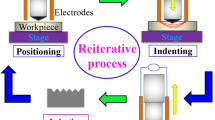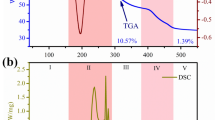Abstract
Vertical cracks can be generated in the top coat of thermal barrier coatings (TBCs) deposited by atmospheric plasma spraying (APS). Since they are known to improve the durability of TBCs such as in the case of dense vertically cracked TBC, clarification of the mechanism and the criteria of cracking are very important. In this study, generation of such vertical cracks was monitored during APS process by laser acoustic emission (AE) method, which is an in situ, non-contact, and non-destructive technique. Temperature was also monitored inside and on the surface of a specimen during APS process for estimation of the temperature field in the top coat. Results of the AE and temperature monitoring were combined to evaluate the relationship between cracking and thermal stress in the top coat. Most of the AE events due to the generation of vertical cracks were detected during rapid heating of the surface of the top coat by the heat flux from the torch. It showed that the vertical cracks were induced due to the tensile stress caused by the temperature difference in the top coat from the rapid heating. Furthermore, the estimated critical thermal stress for vertical cracking from the monitoring results was consistent with a previously reported strength of YSZ coating deposited by thermal spray.












Similar content being viewed by others
References
N.P. Padture, M. Gell, and E.H. Jordan, Thermal Barrier Coatings for Gas-Turbine Engine Applications, 2002, 296, p 280-284
R.A. Miller, Current Status of Thermal Barrier Coatings—An Overview, Surf. Coat. Technol., 1987, 30, p 1-11
S. Kuroda and T.W. Clyne, The Quenching Stress in Thermally Sprayed Coatings, Thin Solid Films, 1991, 200, p 49-66
T.A. Taylor, US Patent 5073433, 1989.
D.M. Gray, Y.C. Lau, C.A. Johnson, M.P. Boron, and W.A. Nelson, US Patent 5830586, 1996.
A.G. Evans, D.R. Mumm, J.W. Hutchinson, G.H. Meier, and F.S. Pettit, Mechanisms Controlling the Durability of Thermal Barrier Coatings, Progress Mater. Sci., 2001, 46, p 505-553
M. Karger, R. Vaßen, and D. Stöver, Atmospheric Plasma Sprayed Thermal Barrier Coatings with High Segmentation Crack Densities, Spraying Process, Microstructure and Thermal Cycling Behavior, Surf. Coat. Technol., 2011, 206, p 16-23
K. Sfar, J. Aktaa, and D. Munz, Numerical Investigation of Residual Stress Fields and Crack Behavior in TBC Systems, Mater. Sci. Eng A, 2002, 333, p 351-360
H.B. Guo, S. Kuroda, and H. Murakami, Segmented Thermal Barrier Coatings Produced by Atmospheric Plasma Spraying Hollow Powders, Thin Solid Films, 2006, 506–507, p 136-139
H.B. Guo, S. Kuroda, and H. Murakami, Microstructures and Properties of Plasma-sprayed Segmented Thermal Barrier Coatings, J. Am. Ceram. Soc., 2006, 89, p 1432-1439
M. Watanabe, M. Enoki, and T. Kishi, Fracture Behavior of Ceramic Coatings During Thermal Cycling Evaluated by Acoustic Emission Method Using Laser Interferometers, Mater. Sci. Eng. A, 2003, 359, p 368-374
S. Nishinoiri, M. Enoki, and K. Tomita, Evaluation of Microfracture Mode in Ceramic Coating During Thermal Cycle Test Using Laser AE Technique, Mater. Trans., 2004, 45, p 92-101
S. Nishinoiri, M. Enoki, and K. Tomita, In Situ Monitoring of Microfracture During Plasma Spray Coating by Laser AE Technique, Sci. Technol. Adv. Mater., 2003, 4, p 623-631
K. Taniguchi, M. Enoki, M. Watanabe, S. Kuroda, and K. Ito, In-Situ Monitoring of Cracking Behaviors of Plasma Sprayed Coatings by the Laser Acoustic Emission Technique, J. Mater. Res., 2009, 24, p 3182-3189
K. Ito, S. Ohmata, K. Kobayashi, M. Watanabe, S. Kuroda, and M. Enoki, Crack Monitoring during Plasma Spraying of Ceramic Coatings by Non-Contact Acoustic Emission Method, Mater. Trans., 2010, 51, p 1272-1276
H.W. Ng and Z. Gan, A Finite Element Analysis Technique for Predicting as-Sprayed Residual Stresses Generated by the Plasma Spray Coating Process, Finite Elem. Anal. Design, 2005, 41, p 1235-1254
K. Ito, H. Kuriki, M. Watanabe, S. Kuroda, and M. Enoki, Detection of AE Events Due to Cracks in TBC During Spraying Process, Mater. Trans., 2012, 53, p 671-675
K. Ito, H. Kuriki, H. Araki, S. Kuroda, and M. Enoki, Detection of Segmentation Cracks in Top Coat of TBCs During APS by Non-Contact AE Method, Sci. Technol. Adv. Mater., 2014, 15, p 035007
K. Ito and M. Enoki, Acquisition and Analysis of Continuous Acoustic Emission Waveform for Classification of Damage Sources in Ceramic Fiber Mat, Mater. Trans., 2007, 48, p 1221-1226
K. Ito, M. Watanabe, S. Kuroda, and M. Enoki, Evaluation of Cracking due to Dynamic Temperature Fluctuation during Plasma Spraying Process by Laser AE Method, Strength Fract. Complex., 2011, 7, p 177-183
S. Rangaraj and K. Kokini, Estimating the Fracture Resistance of Functionally Graded Thermal Barrier Coatings from Thermal Shock Tests, Surf. Coat. Technol., 2003, 173, p 201-212
K.A. Khor, Y.W. Gu, and Z.L. Dong, Mechanical Behavior of Plasma Sprayed Functionally Graded YSZ/NiCoCrAlY Composite Coatings, Surf. Coat. Technol., 2001, 139, p 200-206
Acknowledgment
We thank Mr. Hiraoka and Mr. Komatsu for supporting fabrication of our equipment and operation of the APS system. This work was partially supported by MEXT/JSPS KAKENHI Grant Number 23246124.
Author information
Authors and Affiliations
Corresponding author
Rights and permissions
About this article
Cite this article
Ito, K., Kuriki, H., Araki, H. et al. Evaluation of Generation Mechanism of Vertical Cracks in Top Coat of TBCs During APS Deposition by Laser AE Method. J Therm Spray Tech 24, 848–856 (2015). https://doi.org/10.1007/s11666-015-0247-x
Received:
Revised:
Published:
Issue Date:
DOI: https://doi.org/10.1007/s11666-015-0247-x




